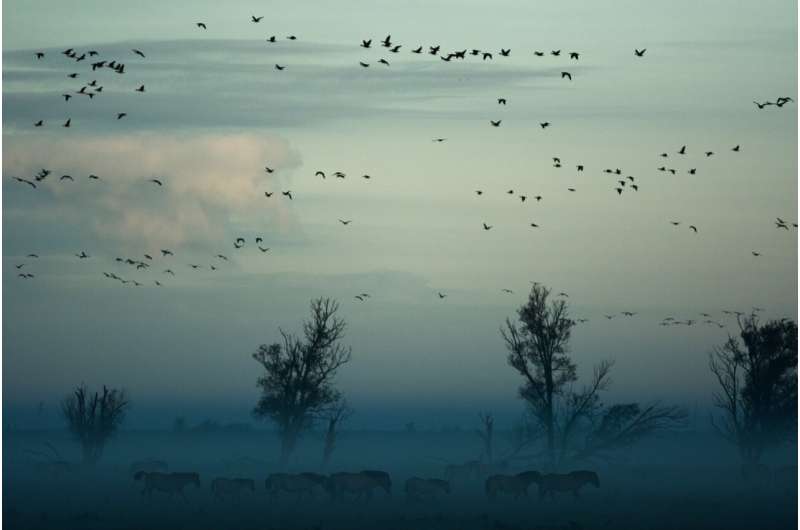This article has been reviewed according to Science X's editorial process and policies. Editors have highlighted the following attributes while ensuring the content's credibility:
fact-checked
peer-reviewed publication
trusted source
proofread
Research reveals the secret sites where America's migrating songbirds stop to rest and refuel

Every year, billions of birds migrate thousands of miles from their summer breeding ranges to their warmer wintering ranges and back. However, the question of where these birds stop to rest and refuel along the way has long stumped ornithologists.
Princeton Ph.D. student Fengyi Guo and her colleagues from Princeton and the University of Delaware address this question in a newly published paper by using weather radar imagery to map the birds' migratory stopover sites in North America.
Using weather surveillance radar to compute and compare bird movement patterns across five years of spring and fall migrations, Guo and her team pinpointed over 2.4 million hectares of land as key stopover hotspots for land birds across the eastern United States.
"Most land birds migrate at night, and they typically lift off from their stopover site to continue their journeys shortly after sunset. Weather radar actually captures this movement of birds, but it requires a lot of processing of the data," explains Guo.
"Each weather radar actively samples the atmosphere every 6-10 minutes and can detect the take-off of birds up to 80 km in radius. Sampling the nightly take-off patterns gives us the spatial details of the daily stopover habitat use of those transient migrants."
The fast-growing field of radar ornithology provides an invaluable peek at the secret lives of migratory birds at an unprecedented scale. David Wilcove, a C-PREE faculty member and co-author of the paper, explains the importance.
"Fengyi's work using weather radar images of migration provides us with the first accurate picture of where the key stopover sites for these birds are across the eastern United States," Wilcove explains. "This information is incredibly important. Without it, we wouldn't know which sites to protect to ensure safe passage for the birds."
The radar imagery showed that stopover hotspots along the eastern U.S. consist primarily of deciduous forests, including forest fragments in broadly deforested regions. These hotspots serve as crucial pitstops for large numbers of land birds each year. Protecting these sites helps to ensure the long-term viability of all the bird species that sojourn at these sites.
However, only half of the currently protected hotspots are free from any form of extractive resource use, and two-thirds of all identified hotspots lack any formal protection at all. Guo also found substantial seasonal differences in where hotspots were located.
In other words, the places where birds choose to rest and refuel in the fall often do not overlap with the places they use on their return flights in the spring. Overall, only 17% of hotspots were shared in both seasons. This suggests that sufficiently safeguarding landbirds along both legs of their thousand-mile journeys will require the protection of a large number of sites spread across the eastern half of the country.
Since 1970, migratory bird populations have plummeted by more than a quarter in the United States, a loss attributable to a host of human-induced factors, including habitat loss, overexploitation, and climate change. In their paper, the authors emphasize the importance of protecting key habitats:
"We found generally higher stopover densities in protected areas than in unprotected areas in both seasons," the report states. "A well-distributed network of well-protected stopover areas, complementing conservation efforts on the breeding and wintering grounds, is essential to sustaining healthy populations of migratory landbirds in North America."
The findings are published in the journal Current Biology.
More information: Fengyi Guo et al, Seasonal patterns and protection status of stopover hotspots for migratory landbirds in the eastern United States, Current Biology (2023). DOI: 10.1016/j.cub.2023.11.033
Journal information: Current Biology
Provided by Princeton University




















